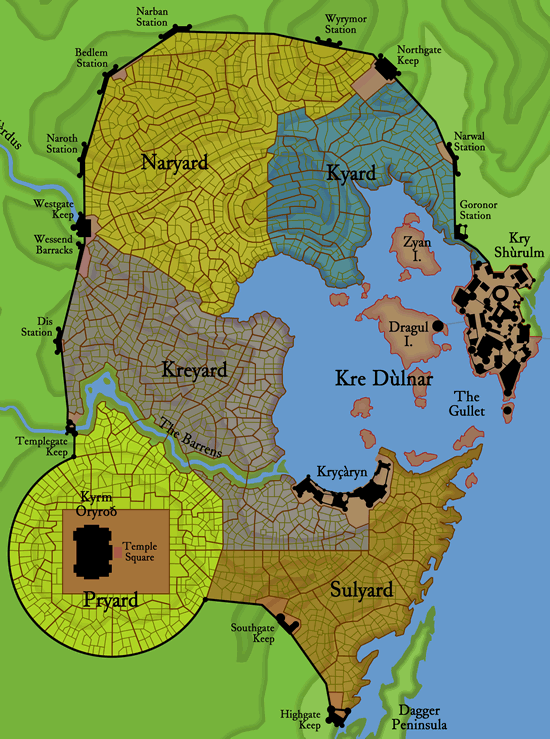City of Iron
- Ruler(s) – Council of Lords
- Population – Oðyr 298,400 (650 DR)
- Elevation – 90 feet
The northernmost city of the Old Empire sits above the ragged Kre Dùlnar. A massive city of nearly 300,000 residents, the city is surrounded by verdant farmland and thick primeval forests. The walled City of Oð itself is covered by an omnipresent oily black pall which rotates above a towering mountain of iron, which is the Temple of Roð. This massive edifice is the same artifact described in ancient texts that the god Roð instructed his people to build so that he might come to the world and live and work among them. The Iron Temple’s vents and chimneys still glow with internal fire, evidence of eternal furnaces and forges deep within its walls.
Surrounded by deep forest, sea, rocky hills, and towering mountains, the City is divorced from the surrounding world. An occasional ship passes across the sea’s horizon but few draw near to the harbor’s rocky maw. Those rare ships that do stop keep their distance, not wishing to be visited by the City’s shadows. Fishermen have claimed to see the skeletons of ships that drew too near, their fractured masts standing in the harbor’s murky depths.
Beyond the Northfields bordering the City to the north are the Northwoods, an ancient stand of hardwoods that was once the empire’s border, the end of the “civilized” Yrūni world. The forest is an invaluable resource for the City, providing endless quantities of lumber and game. It is also a source of dread for the people, harboring all forms of mystery and creatures that prey on the wayward.
To the south and west of the City stretch the Black (i.e., Morén Nōdrul) and Fractured (i.e, Morén Burdrul) rocky hills. Pryr Roð teach that the faithful were brought to this place in ancient times because of the land’s abundant mineral resources, so that the Temple could be built according to “god’s design”. The surrounding hills have produced the richest ore mines in the known world, and are now honeycombed with deep and endless tunnels and mines. It is told that many of the mines were spent and abandoned long before the first King was crowned in Oð. Others claim that the oldest mines are not Yrūn mines at all and that the region was picked-over long before the faithful of Roð claimed the hills by their own providence.
The City is serviced by an old but efficient sewage system. There is no running water, though crumbled aqueducts in the South and West suggest there may have been at one time.
Above the rooftops turns a massive ever-present smoky disc (i.e., The Wheel) which casts an impenetrable pall over the city. The Wheel spins above Kyrm Oryroð, preventing most of the day’s light from reaching the city. In the early morning and late evening, sunlight scatters across the blackened rooftops for a few moments as it passes between the Wheel and the city wall. The perimeter of the Wheel does not extend far beyond the north and south city walls.
12d of Eren, 646 — A joyless crowded place crouches darckly above a rocky harbour. High lanterns flikker from anchent walls, relicks of a past that lays heavily on the stones of the City. Here I have lived for fourty years, trudging through the black streets and breething dead aire. I can not begin to describe the melancholy shared by its residents; the mutual sense of foreboding, shared doom. Most that arrive at the gates have been cast by unkind fate onto its shores. It seems there are a thousand whays to reach Oð by no whay out. No roads lead far from the citywalls, and few ships can manage the terrible harbour and crashing coasts. I write now, overcome with emotion. I think it’s happiness. The price even now seems small. Only minutes after leaving port I feel free, at last, I am free.” – last entry in small journal found among the lowtide flotsam of the Kre Dùlnar
Wards
Landmarks
- The Barrens. Like a raw sore, The Barrens stretch from one side of the city to other. The Barrens was formed centuries ago when an earthquake rocked the city, opening a deep ravine along the Run Dul riverbed. The resulting fires devastated a wide swath through the center of the Pryard and Kreyard. The region was never reclaimed by the city’s inhabitants as the newly formed chasm opened dangerous entryways into the Lower Streets.
- City Wall
- Highgate Keep
- Kre Dùlnar
- Kryçàryn
- Kryr Shùrulm
- Kyrm Oryroð
- Northgate Keep
- Orvud College
- Southgate Keep. One of five great gates along the city wall of Oð; a massive barbican with three sets of layered doors that remains largely unused due to the bandit kingdoms of the Sulsàdter. Southgate includes the buildings, baileys, and towers that compose the area around this southwestern gate.
- Templegate Keep. One of five great gates along the city wall of Oð; Templegate includes a massive barbican with three layered sets of heavy wood doors.
- Tower Isle. A stony finger that juts high above the ocean surf off the coast of the Kryr Shùrulm. The top of the isle is a stone tower that was probably connected by an arched span in ancient times, but that has long since crumbled to the rocky waves below.
- Westgate Keep
Groups
Nomenclature: Oð Dekàlic: Oð (place), Oðári (pertaining to), Oðyn (resident), Oðyr (people), Oðic (language)
